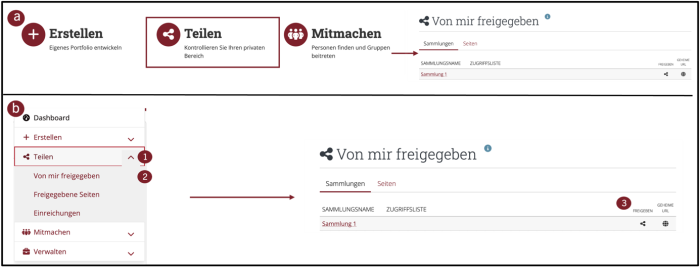en:myportfolio:faq:share
This is an old revision of the document!
Table of Contents
FAQ – Share
1.How can the portfolio be shared?
en/myportfolio/faq/share.1746875566.txt.gz · Last modified: 2025/05/10 11:12 by pdf-f3w
This is an old revision of the document!
To share a page or collection, open the page to be shared. You can access the overview of all your portfolios via the Burger menu at the top right under Create and then Portfolios (a). Or click on Create (b) on the start page (Dashboard).
To share a page or collection, open the page you want to share. You can access the overview of all your portfolios via the Burger menu at the top right under Create and then Portfolios (a). Or click on Create (b) on the start page (Dashboard).

Open the desired page or collection, click on the three dots on the right-hand side and select Manage access. You can then use Share with to decide who you want to share the page or collection with.
Open the desired page or collection, click on the three dots on the right-hand side and select Manage access. You can then use Share with to decide who you want to share the page or collection with.

Shared portfolios can be commented on using the comment function. Feedback can be left for an entire page as well as for individual artifacts such as images. Comments can be left not only by teachers, but by anyone for whom the portfolio has been shared. To allow comments, they must be switched on in the Advanced options when sharing.
To link plans to a group with tasks and templates, you must first create them as a template in your own plan directory. To do this, start with a new plan in the Burger menu under Create - Plans (1).
Create a new plan and activate the template (2). This automatically activates the task definition. If you do not want to use this, it must be deactivated again (3). Then save the templates. You can now fill your template plan with the individual tasks (4).
To link a task, please use the Task page function (5). You can use this to link one of your pages that contains the assignment for your students. The drop-down menu contains all available pages. If you would now also like the students to receive a page as a template, please use the task portfolio (6), here too you can use one of your pages or collections marked as a template in the drop-down menu. Repeat this process for all the tasks you want to set.
Note: Please note that a page can only be used once as a task or portfolio.
To insert your plan in a group, open the plans of the respective group (7) and create a new plan (8).
Now use the From template function (9) to import one of the templates you have created. An overview of the available plan templates opens. Select the template to be added to this group and save it. You can then add further tasks or edit the settings for this plan.
Über die Funktion des SmartEvidenceFramework können verschiedene Kompetenzen und Skills mittels Aufgaben und dazugehörigen Abschlussanforderungen visualisiert werden. Dieses Framework ist nicht individuell erstellbar, sondern nur über die myPortfolio-Administrierenden für alle verfügbar zu machen. Bisher gibt es zwei Frameworks: Career Readiness und Standards for the teaching profession.
Die Darstellung erfolgt über eine Erfolgsmatrix, die SmartEvidenceMap, über welche auch die zugehörigen Seiten und Sammlungen mit den Aufgaben verknüpft sind. Hierbei gibt es drei Bewertungsmöglichkeiten:
Innerhalb der SmartEvidenceMap kann entweder eine Selbst- oder eine Fremdbewertung erfolgen, diese ist im Gegensatz zu der Bewertung einer Abgabe korrigierbar. Bei einer veränderten Bewertung wird ein Bewertungsverlauf erzeugt. Eine Rückmeldung per Kommentar ist immer möglich, unabhängig von der Art der Bewertung.
Welche Möglichkeiten es für Studierende und Lehrende gibt, Rückmeldung zu einem Portfolio zu geben, erklären wir Ihnen auf unserer Wiki-Seite Feedback options.